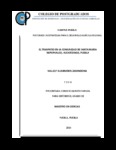| dc.contributor.author | Guarneros Zarandona, Nallely. | |
| dc.creator | GUARNEROS ZARANDONA, NALLELY; 343184 | |
| dc.date.accessioned | 2015-02-04T23:49:34Z | |
| dc.date.available | 2015-02-04T23:49:34Z | |
| dc.date.issued | 2014 | |
| dc.identifier.uri | http://hdl.handle.net/10521/2554 | |
| dc.description | Tesis (Maestría en Ciencias, especialista en Estrategias para el Desarrollo Agrícola Regional).- Colegio de Postgraduados, 2014. | es_MX |
| dc.description.abstract | El presente estudio se realizó en la comunidad de Santa María Nepopualco, municipio de Huejotzingo, Puebla. Las unidades domésticas campesinas (UDC) fueron la unidad de estudio, con el objetivo de describir y cuantificar la diversidad de los sistemas de traspatio y comparar entre familias migrantes y no migrantes. Se estudió el número y uso de los componentes vegetales y animales de los traspatios. La muestra (n) fue de 123 UDC con un nivel de confianza de 95%, dentro de estas unidades domesticas se consideró informante clave al responsable de los traspatios a quienes se aplicó un cuestionario. La información recolectada fue analizada con el software estadístico SPSS. Para cuantificar la diversidad del traspatio se obtuvo un índice de diversidad (H´) mediante el uso del software Ecosim700. Los principales resultados de la investigación mostraron que el total de los integrantes de la muestra cuenta con una superficie promedio de traspatio de 29.3 metros cuadrados. El índice de diversidad vegetal (H´) fue de 3.45 bits, considerado alto, con un total de 130 especies vegetales, de las cuales 44% corresponde a especies ornamentales, 19% frutales, 16% medicinales y condimentos, 9% hortalizas, 8% árboles y arbustos, y el 7% restante lo conforman cactáceas, semillas y forrajeras; y un índice de diversidad animal (H´) de 4.4 bits con 11 especies animales, entre las principales, las aves, porcinos, ovinos, bovinos y caprinos. La migración se relaciona en gran medida con la producción y diversidad vegetal de los traspatios. Es necesario valorar el sistema de traspatio como unidad de conservación de la biodiversidad por los beneficios (nutrimentales y económicos) que se obtienen. _______________ BACKYARD FARMING IN THE COMMUNITY OF SANTA MARÍA NEPOPUALCO, HUEJOTZINGO, PUEBLA. ABSTRACT: This study took place in the community of Santa María Nepopualco, part of the municipality of Huejotzingo, Puebla. The Farming Domestic Units (FDU) were the study units, in the purpose of describing and quantifying the diverse backyard farming systems, and differentiate migrant and non-migrant families. The plant and animal number of the components of the backyard systems and their uses were studied. The sample (n) was of 123 FDUs with a reliability level of 95 %, considering the responsible of the backyard, who filled out an evaluative instrument, as key informant. SPSS statistical software was used for data analysis of the collected information. In order to account for the backyard diversity a plant diversity index (H´) was obtained via Ecosim700 software. The main result of the research shows that the total of the analysis members have an average backyard surface of 29.3 square meters. The plant diversity index (H’) consisted of 3.45 bits, being considered as high, with a total of 130 vegetable species, from which 44% belonged to the group of ornamentals, 19% fruits, 16% medicinal and spices, 9% vegetable, 8% trees and bushes, and the remaining 7% cacti, seeds and forage. As well as an animal diversity index (H´), of 4.4 bits with 11 animal species, comprising birds, porcine, ovine, bovine and goats. Migration is greatly related to the production and plant diversity in the backyards. It is important to value backyard systems as preservation units for biodiversity due to the benefits obtained (nutrimental and economic). | es_MX |
| dc.description.sponsorship | Consejo Nacional de Ciencia y Tecnología (CONACyT). | es_MX |
| dc.language.iso | spa | es_MX |
| dc.rights.uri | http://creativecommons.org/licenses/by-nc-nd/4.0 | |
| dc.subject | Índice de diversidad | es_MX |
| dc.subject | Migración | es_MX |
| dc.subject | Traspatio | es_MX |
| dc.subject | Unidades domésticas campesinas | es_MX |
| dc.subject | Backyard farming | es_MX |
| dc.subject | Diversity index | es_MX |
| dc.subject | Farming domestic units | es_MX |
| dc.subject | Migration | es_MX |
| dc.subject | EDAR | es_MX |
| dc.subject | Estrategias para el Desarrollo Agrícola Regional | es_MX |
| dc.subject | Maestría | es_MX |
| dc.title | El traspatio en la comunidad de Santa María Nepopualco, Huejotzingo, Puebla | es_MX |
| dc.type | Tesis | es_MX |
| Tesis.contributor.advisor | Cruz Hernández, Javier. | |
| Tesis.contributor.advisor | Morales Jiménez, Juan. | |
| Tesis.contributor.advisor | Huerta de la Peña, Arturo. | |
| Tesis.contributor.advisor | Ávalos de la Cruz, Dora Angélica. | |
| Tesis.date.submitted | 2014 | |
| Tesis.date.accesioned | 42034 | |
| Tesis.date.available | 42038 | |
| Tesis.format.mimetype | pdf | es_MX |
| Tesis.format.extent | 3,545 KB | es_MX |
| Tesis.subject.nal | Migración rural urbana | es_MX |
| Tesis.subject.nal | Rural urban migration | es_MX |
| Tesis.subject.nal | Conocimiento tradicional | es_MX |
| Tesis.subject.nal | Indigenous knowledge | es_MX |
| Tesis.subject.nal | Entorno sociocultural | es_MX |
| Tesis.subject.nal | Sociocultural environment | es_MX |
| Tesis.subject.nal | Entorno socioeconómico | es_MX |
| Tesis.subject.nal | Socioeconomic environment | es_MX |
| Tesis.subject.nal | Población rural | es_MX |
| Tesis.subject.nal | Rural population | es_MX |
| Tesis.subject.nal | Pobreza rural | es_MX |
| Tesis.subject.nal | Rural poverty | es_MX |
| Tesis.subject.nal | Estructura familiar | es_MX |
| Tesis.subject.nal | Family structure | es_MX |
| Tesis.subject.nal | Santa María Nepopualco, Huejotzingo, Puebla, México | es_MX |
| Tesis.rights | Acceso abierto | es_MX |
| Articulos.subject.classification | Comunidades rurales | es_MX |
| dc.type.conacyt | masterThesis | |
| dc.identificator | 5 | |
| dc.contributor.director | CRUZ HERNANDEZ, JAVIER; 629254 | |


